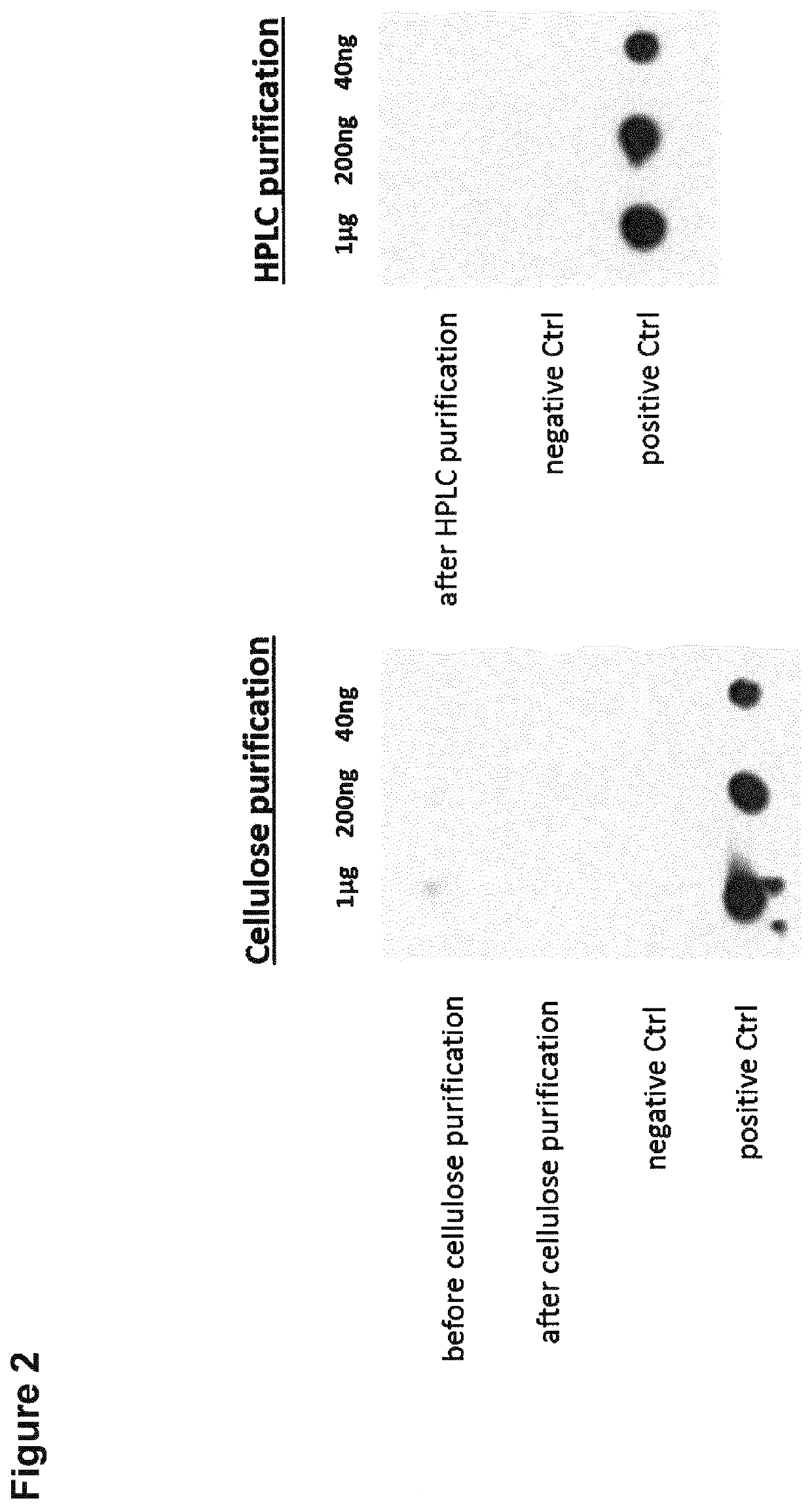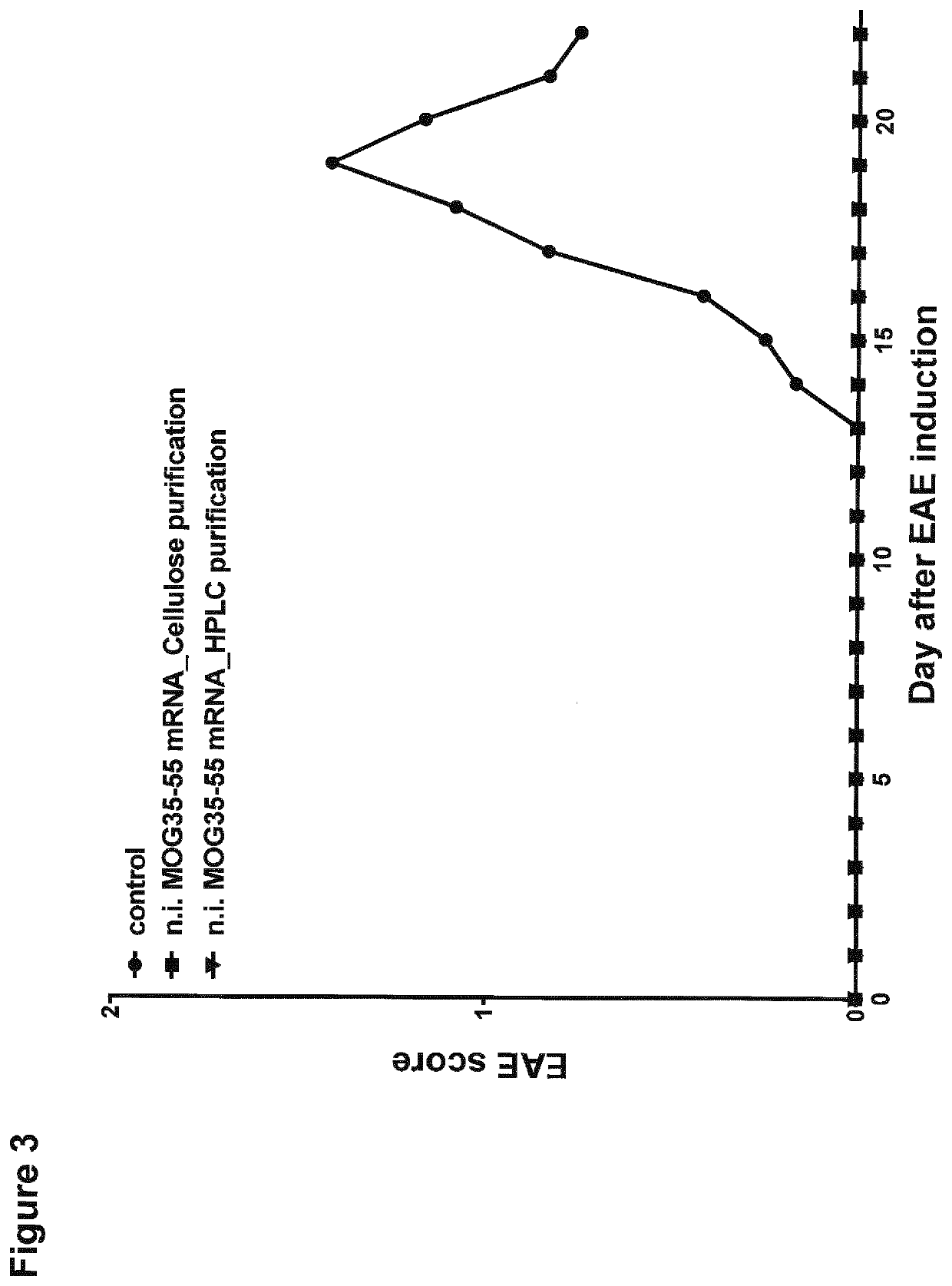RNA for treatment of autoimmune diseases
a technology for autoimmune diseases and rna, which is applied in the field of rna for the treatment of autoimmune diseases, can solve the problems of difficult eliciting appropriate immune responses, limited success of therapies, and undesirable effects of the immune system
- Summary
- Abstract
- Description
- Claims
- Application Information
AI Technical Summary
Benefits of technology
Problems solved by technology
Method used
Image
Examples
example 1
and Methods
[0238]Animals
[0239]C57BL / 6, BALB / c, SJL / JRj wild-type mice and F1 hibrid mice from C57BL / 6 and SJL / JRj were purchased from ENVIGO RMS gmbH, Netherlands and Janvier Laboratories, France respectively. Thy1.1+ 2D2 TCR MOG transgenic C57BL / 6 mice, expressing a T cell receptor recognizing MOG35-55 in the context of MHC class II (I-Ab), as well as Thy1.1+ 2D2 Foxp3-eGFP TCR MOG transgenic C57BL / 6 mice that additionally include the knock-in Foxp3-eGFP, were kindly provided by the laboratory of Prof. Dr. Ari Waisman. Age and sex matched animals were used throughout the experiments and mice were maintained under specific pathogen-free (SPF) conditions at the animal facility of BioNTech AG Mainz.
[0240]RNA Constructs and In Vitro Transcription
[0241]In vitro transcription of LUC-mRNA were based on the pST1-hAg-CDS-FI-A30LA70 plasmid-backbone, which contains a 5′ human alpha globin UTR (hAg), a 3′ FI element and a poly(A) tail of 100 nucleotides, with a linker after 30 nucleotides. Th...
example 2
on of Non-Immunogenic mRNA Regarding Activation of Splenocytes
[0289]In order to analyze the activation of splenocytes and translation efficiency of the used non-immunogenic mRNA, BALB / c mice were injected intravenously into the retro-orbital plexus with Luciferase-mRNA (10 μg) complexed with F12 liposomes. Luciferase activities were assessed via in vivo imaging 6, 24, 48 and 72 hours after RNA-LPX injection and representative mice are shown in FIG. 1C. Immunization of mice with non-immunogenic mRNA led to a lasting high translation of the LUC-mRNA. Consequently LUC protein expression could be detected up to 72 hours after mRNA immunization.
[0290]Furthermore, as seen in FIG. 1A, immunization of mice with non-immunogenic mRNA led to no upregulation of activation markers CD86 on DCs and CD69 on lymphocytes like in untreated control mice. In mice immunized with non-immunogenic LUC-mRNA also no IFNα could be detected in the blood 6 hours after mRNA immunization (FIG. 1B).
example 3
ization of Non-Immunogenic mRNA
[0291]Non-immunogenic mRNA is used to deliver specific disease relevant antigens to dendritic cells to ensure antigen-presentation without immune activation in therapeutic applications. It has been shown that the incorporation of 1-methylpseudouridine into mRNA enhances the protein expression in the cells and reduces the immunogenicity of the mRNA in mammalian cell lines as well as in vivo in mice (Andries et al., 2015, J Control Release. 217, 337-344). This effect relies most likely on the increased ability of the mRNA to evade activation of endosomal Toll-like receptors and downstream innate immune signaling (Andries et al., 2015). Additionally to the use of 1-methylpseudouridine instead of the nucleoside uridine for the incorporation into the mRNA during in vitro transcription, HPLC purification of the synthetic mRNA eliminates furthermore immune activation and improves the translation of the nucleoside-modified, protein-encoding mRNA (Kariko et al....
PUM
| Property | Measurement | Unit |
|---|---|---|
| Composition | aaaaa | aaaaa |
| Immunogenicity | aaaaa | aaaaa |
Abstract
Description
Claims
Application Information
 Login to View More
Login to View More - R&D
- Intellectual Property
- Life Sciences
- Materials
- Tech Scout
- Unparalleled Data Quality
- Higher Quality Content
- 60% Fewer Hallucinations
Browse by: Latest US Patents, China's latest patents, Technical Efficacy Thesaurus, Application Domain, Technology Topic, Popular Technical Reports.
© 2025 PatSnap. All rights reserved.Legal|Privacy policy|Modern Slavery Act Transparency Statement|Sitemap|About US| Contact US: help@patsnap.com



